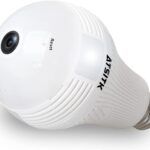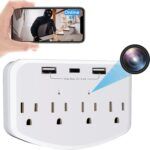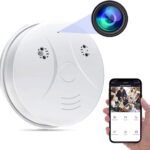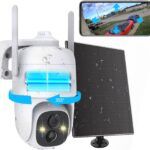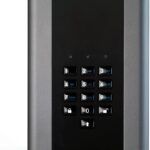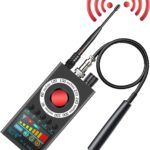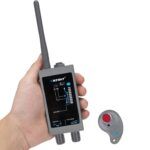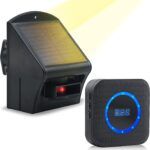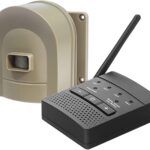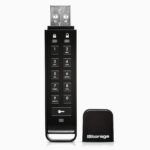- How does access point mode work in surveillance cameras?
Access point (AP) mode in surveillance cameras enables them to function as standalone wireless networks. When a surveillance camera is set to access point mode, it acts as a Wi-Fi hotspot, creating its own network that other devices can connect to. This mode eliminates the need for an existing Wi-Fi network or internet connection, making it suitable for remote locations or areas with limited network access.
In access point mode, the surveillance camera broadcasts its own Wi-Fi signal, allowing devices such as smartphones, tablets, or computers to connect directly to the camera’s network. Users can access the camera’s live feed, configure settings, and review recorded footage through a dedicated app or web interface.
This mode provides flexibility and convenience, as users can connect to the camera even when there is no existing network infrastructure available. It also simplifies the installation process since there is no dependency on existing Wi-Fi networks or complex network configurations.
Access point mode offers a versatile solution for surveillance needs in various scenarios, including temporary setups, remote monitoring, or areas where traditional network connectivity is challenging.
- Can hidden cameras with AP mode function without an internet connection?
Hidden cameras with access point mode can function without an internet connection. Access point mode allows the camera to create its own local Wi-Fi network, enabling direct communication between the camera and connected devices without the need for an external network or internet access. This feature is particularly useful in situations where internet connectivity is not available or desired.
When operating in access point mode, the camera and connected devices communicate internally within the created network, enabling surveillance functionality even in environments without internet connectivity. It provides a self-contained surveillance solution that offers flexibility, convenience, and independence from external network infrastructure.
- How do I connect my smartphone to a camera in AP mode?
Connecting your smartphone to a hidden camera in access point mode is a relatively straightforward process. First, ensure that the hidden camera is powered on and operating in access point mode. This mode is typically activated by pressing a designated button or through the camera’s configuration settings. Once the camera is in access point mode, it will create its own Wi-Fi network.
On your smartphone, go to the Wi-Fi settings and search for available networks. You should see the network name (SSID) of the camera’s access point listed. Select the camera’s network from the available options and enter the corresponding password if prompted. The password is usually provided with the camera’s documentation or can be found on the camera itself.
After successfully connecting to the camera’s network, you can launch the associated camera viewing app or use a web browser to access the camera’s interface. The app or interface will allow you to view the live feed, configure settings, and control the camera’s functionality directly from your smartphone. It’s important to note that while connected to the camera’s access point, you won’t have internet access unless the camera has additional functionality to bridge to an external network.
- Is AP mode compatible with both iOS and Android devices?
Surveillance cameras with access point feature are generally compatible with both iOS and Android devices. Access point mode relies on creating a standard Wi-Fi network that your smartphone can connect to, regardless of the operating system. As long as your iOS or Android device has Wi-Fi capabilities, you should be able to connect to the camera’s access point network and access its features and live feed.
To connect your iOS device, such as an iPhone or iPad, simply go to the Wi-Fi settings and select the hidden camera’s network from the available options. Enter the password if prompted, and once connected, you can access the camera’s interface or associated app to view the live feed and control the camera’s settings.
Similarly, for Android devices, navigate to the Wi-Fi settings, locate the hidden camera’s network, and connect to it by entering the password if required. Once connected, you can use the camera’s app or web interface to interact with the camera and access its features.
It’s worth noting that specific camera models may have their own dedicated apps or compatibility requirements, so it’s advisable to check the camera’s documentation or manufacturer’s website for any device-specific instructions or recommendations.
- What is the range of the access point mode in hidden cameras?
The range of the access point mode in hidden cameras can vary depending on several factors, including the camera’s design, antenna strength, and surrounding environment. In general, the access point range is typically limited to a certain distance, often within the range of a typical Wi-Fi network.
Most hidden cameras with local network mode will have a range of around 30 to 100 feet (9 to 30 meters) in an open area without obstacles. However, keep in mind that the range can be affected by walls, furniture, and other objects that can interfere with the Wi-Fi signal. Thick walls or long distances may decrease the effective range and signal strength.
It’s important to consider the intended placement and usage scenario when determining the range of the access point mode. If you plan to use the hidden camera in a larger area or a location with many obstacles, it may be beneficial to test the signal strength and range before finalizing the camera’s placement.
Additionally, using Wi-Fi signal boosters or extending the network range with additional access points or repeaters can help improve the coverage area of the hidden camera’s access point mode.
- Can multiple devices connect to a hidden camera in access point mode simultaneously?
In most cases multiple devices can connect to a camera in access point mode simultaneously. AP or direct connection mode allows the spy camera to act as a Wi-Fi hotspot, enabling multiple devices such as smartphones, tablets, or computers to establish a connection directly with the camera. This means that you can view the camera’s live feed or access its settings from multiple devices at the same time.
The number of devices that can connect to the hidden camera in access point mode simultaneously may vary depending on the specific camera model and its technical capabilities. Some cameras may have a limit on the number of concurrent connections, while others may allow a higher number of devices to connect without issues. It’s always recommended to check the camera’s specifications or user manual to determine the maximum number of supported connections.
Having the ability for multiple devices to connect to the hidden camera simultaneously can be beneficial in scenarios where multiple users or team members need to access the camera’s footage or control its settings from different devices, providing flexibility and convenience in surveillance operations.
- Is the footage recorded by hidden cameras with access point mode encrypted?
The encryption of recorded footage in hidden cameras with access point mode can vary depending on the specific camera model and its features. While some hidden cameras may offer encryption for the recorded footage, not all cameras may have this capability. It’s important to carefully review the specifications and features of the camera you are considering to determine if it includes encryption for recorded video data.
Encryption adds an additional layer of security to the footage, ensuring that it cannot be easily accessed or viewed by unauthorized individuals. With encryption, the recorded video data is encoded using cryptographic algorithms, making it difficult for anyone without the proper decryption key to decode and access the footage. This feature is particularly important in scenarios where privacy and data security are crucial considerations.
If having encrypted footage is a priority for you, it is recommended to look for hidden spy camera models that specifically mention encryption as one of their features. This way, you can ensure that your recorded video data remains secure and protected from unauthorized access.
For secure data storage don’t forget to check our Encrypted data drives, which include military-grade encrypted hard drives and USB flash drives.
- How to set up and configure a hidden camera in access point mode?
Setting up and configuring a hidden camera in AP mode typically involves a few straightforward steps. First, ensure that the camera is powered on and in access point mode, which is usually indicated by a status light or LED. Then, using your smartphone or computer, locate the Wi-Fi network generated by the hidden camera in the list of available networks.
Connect to the camera’s Wi-Fi network using the provided credentials, which are usually mentioned in the camera’s user manual or accompanying documentation. Once connected, open a web browser or the dedicated mobile app for the camera and follow the on-screen instructions to access the camera’s configuration settings.
In the camera’s configuration settings, you can customize various options such as network settings, video quality, motion detection sensitivity, and recording preferences. You may also have the option to set up notifications or remote access for viewing the live feed or recorded footage from your smartphone or computer. It’s important to carefully follow the instructions provided by the manufacturer to ensure proper setup and configuration of the camera in hotspot mode.
- Are hidden cameras with access point mode secure?
Hidden cameras with AP mode can provide a level of security, but it’s important to understand the specific features and considerations to ensure their effectiveness. In access point mode, these cameras create their own Wi-Fi network, which means the footage is transmitted directly to connected devices without relying on an external network. This can offer increased security as it reduces the exposure to potential hacking or unauthorized access through the internet.
However, the overall security of hidden cameras with hotspot functionality depends on various factors. It’s crucial to choose cameras from reputable manufacturers that prioritize security measures like encryption protocols and password protection. Regular firmware updates are also essential to address any potential vulnerabilities.
Additionally, you should take steps to secure connected devices, such as using strong passwords, enabling two-factor authentication, and keeping your devices and apps up to date. By following best practices and using reliable equipment, hidden cameras with non-internet local WiFi network mode can provide an additional layer of security for personal or professional surveillance needs.
- Are AP camera's WiFi networks visible to anyone in range?
In most cases, access point (AP) cameras create their own Wi-Fi networks that are not visible to anyone in range by default. These networks are typically hidden or non-broadcasted, which means they won’t appear in the list of available Wi-Fi networks on nearby devices. This adds an extra layer of security as it makes it more challenging for unauthorized users to detect or connect to the camera’s network.
To access the camera’s network, users need to manually configure their devices to connect to the specific network name (SSID) and enter the corresponding password provided by the camera. This ensures that only authorized users with knowledge of the network details can connect to the camera and access its live feed or settings.
However, it’s worth noting that some AP cameras may offer the option to enable broadcasting of the network for easier setup or configuration purposes. In such cases, the camera’s network may become visible to nearby devices temporarily. It’s important to review the camera’s documentation or settings to understand the visibility options and adjust them according to the desired level of security.
- Is Access Point and Hotspot mode on cameras same?
Access Point mode and Hotspot mode, while similar in some aspects, are not exactly the same in other devices. When it comes to cameras, AP mode or hotspot mode generally refers to the camera’s capability to function as a standalone access point, allowing other devices to connect directly to the camera’s network.
This functionality is also often referred to as standalone or local network mode, direct connection mode, peer-to-peer connection, or offline mode. Regardless of what manufacturers call it, in this mode the camera acts as a Wi-Fi router, creating its own network to which other devices can connect. This allows for direct communication and access to the camera’s features and functionalities without the need for an existing Wi-Fi network.
- Can a camera work in Access Point and regular WiFi internet connection at the same time?
Whether a camera can work in both Access Point mode and a regular Wi-Fi internet connection simultaneously depends on the specific camera model and its capabilities. Some cameras may offer the flexibility to function in both modes concurrently, while others may only support one mode at a time.
In scenarios where the camera supports simultaneous operation, it can serve as an Access Point for direct device connections while also being connected to an existing Wi-Fi network for internet access and remote monitoring. This setup allows for increased flexibility in managing the camera and accessing its features from both local and remote devices.
However, it’s important to note that not all cameras have this dual-mode capability, and it may vary depending on the manufacturer and model. Therefore, it’s advisable to consult the camera’s documentation or reach out to the manufacturer for specific information regarding the simultaneous usage of Access Point and regular Wi-Fi internet connection.
Hidden cameras with access point mode (AP) offer a versatile and convenient surveillance solution that combines the features of a surveillance camera and a Wi-Fi access point. These cameras can function as standalone devices, creating their own Wi-Fi network that allows direct connection and live streaming access to the camera’s feed without the need for an existing Wi-Fi network.
Showing all 2 products:

Hidden cameras with access point mode offer a discreet and versatile surveillance solution. These cameras are designed with built-in Wi-Fi capabilities that allow them to create their own access point, enabling direct communication with your smartphone or other devices. With access point (AP) mode, you don’t need an existing Wi-Fi network or internet connection, making it ideal for situations where traditional connectivity options are limited or not available.
By establishing a direct connection between the hidden camera and your device, you can easily access the live feed, view recordings, and control camera settings from anywhere within range. This hotspot mode provides convenience and flexibility, allowing you to set up and monitor the camera without relying on external networks.
Whether you need to monitor your home, office, or any other space, hidden cameras with access point mode provide a secure and reliable solution that ensures your privacy while delivering reliable surveillance capabilities.
Access Point FAQs


